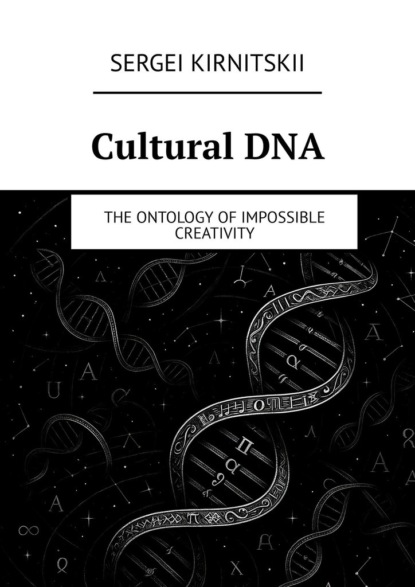Cultural DNA. The Ontology of Impossible Creativity

- -
- 100%
- +

© Sergei Kirnitskii, 2025
ISBN 978-5-0068-3985-4
Created with Ridero smart publishing system
INTRODUCTION: THE PHOTO FROM THE BAR AND BIRTH OF THEORY
A woman sends a photograph from a bar. An ordinary evening, an ordinary place, nothing special. Except for one detail. Above the cash register, between bottles and price tags, hangs a portrait of Mendeleev. Not a rock star poster, not a beer advertisement, not an abstract painting for the interior. Dmitri Ivanovich Mendeleev himself gazes at the patrons from a gilded frame.
This is what I’d call a philosophical revelation. More precisely: an instantaneous grasping of structure. Mendeleev above a bar cash register. This is not coincidence. Not the owner’s irony. Not an attempt to shock the public. This is the manifestation of a deep cultural logic that works with the inevitability of physical law.
Why Mendeleev specifically? Why not Pushkin, not Gagarin, not Peter the Great? Because in the Russian cultural matrix, science functions as a special kind of sacred. Mendeleev’s table is order wrested from chaos, a system conquering randomness. In a culture where chaos is always near, where «perhaps» and «somehow» shape the everyday, the figure of the scientist who created the universal order of elements acquires an almost religious significance.
But this isn’t about Russia. And it’s not about Mendeleev. This portrait above the cash register makes visible a universal principle: any culture places its symbols according to an invisible but iron logic. This logic is not chosen consciously. It reproduces itself automatically, like breathing, like heartbeat, like the fall of a thrown stone.
Looking at the photograph, I saw something more than a cultural peculiarity. I saw the working of what could be called cultural DNA. The inescapable process of reproducing cultural structures through any human action. And most importantly, I understood why this DNA is inevitable.
If consciousness is the process of operating cultural codes, and it has no other tools, then cultural signature is inevitable in any product of consciousness. This is not influence that can be overcome. This is not a limitation from which one can be liberated. This is the structural condition of the very possibility of thought and creativity.
Let’s imagine the alternative for a second. What else could consciousness operate with, if not cultural codes? Pure ideas? But the very concept of «pure idea» is a cultural construct of the Platonic tradition. Mathematical abstractions? Mathematics is built on axioms accepted by cultural agreement. Direct sensations? Even the perception of color is structured by linguistic categories. Where Russian sees goluboy and siniy, the English speaker sees shades of blue.
There are no other tools. And there cannot be. Because a tool presupposes someone who uses it, and consciousness doesn’t use cultural codes. It IS the process of operating them. This is not a psychological observation about culture’s influence on humans. This is an ontological assertion about the nature of consciousness as such.
From this formula – consciousness equals the process of operating cultural codes – everything else follows with mathematical inevitability. If consciousness has no other tools, then any creativity is recombination of existing codes. If creativity is recombination, then originality is simply ignorance of sources. If originality is illusion, then the author doesn’t create but conducts cultural currents. If the author is a conductor, then there never was an author in the sense we’re accustomed to thinking about one.
This logical chain unfolds not as philosophical speculation but as the inevitable consequence of the basic formula. Just as all properties of a circle follow from its definition, so the entire ontology of creativity follows from the formula of consciousness.
But here an apparent contradiction arises. If we are locked in cultural codes, how can we see cultural DNA? Where does the capacity for metastructural vision come from, which allows us to grasp entire cultural configurations?
The answer is paradoxical and simultaneously simple. We see cultural DNA not from outside but from inside, through the prism of our own cultural optics. Russian culture with its pull toward metaphysical generalizations, with its ability to see the universal in the particular, creates a special observer position. An American might see kitsch or post-irony in Mendeleev’s portrait. A French person might see a sign of cultural provincialism. A Japanese person might see a disruption of the space’s aesthetic harmony.
Each culture creates its own optics through which certain aspects of reality become visible. And this optics is also part of cultural DNA. We cannot jump out of our own cultural conditioning to see culture «objectively.» But we can use one cultural system as an instrument for examining another.
Metastructural vision is not a view from nowhere. It is the ability to use structures of one domain to understand structures of another. When a mathematician sees fractals in a coastline, he doesn’t leave mathematics. He applies mathematical optics to a natural phenomenon. When a philosopher sees cultural DNA in the placement of a portrait, he doesn’t exit culture. He uses philosophical categories to grasp cultural logic.
This capacity for structure transfer is also a cultural phenomenon. It emerges in cultures that have reached a certain level of abstract thinking. And it is especially developed in the modern epoch, when algorithmic thinking, born of the computer revolution, has taught us to see structures and patterns everywhere.
This is precisely why the theory of cultural DNA appears now, not a hundred years ago. We live in an epoch when the very concept of code has become central: genetic code, computer code, cultural code. We are accustomed to thinking in terms of programs, algorithms, data structures. This optics allows us to see what was hidden from previous generations.
But here we must make an important admission that doesn’t weaken but rather strengthens the theory. This theory of cultural DNA itself bears a cultural signature. It is possible only in a certain cultural context, with a certain set of preceding ideas, at a certain historical moment.
In it one can easily detect traces of the Western philosophical tradition. From Kantian categories to Derridean deconstruction. In it emerges the structuralist heritage with its search for universal structures. In it resonate echoes of Russian philosophy with its striving for holistic vision. In it reflects the contemporary epoch with its algorithmic thinking and experience of interacting with artificial intelligence.
This cultural conditioning is not the theory’s weakness. On the contrary, it serves as its empirical confirmation. If the theory asserts the inevitability of cultural DNA and itself bears cultural DNA, this is recursive validation. A theory that is not applicable to itself is incomplete. A theory that finds in itself what it asserts about others achieves philosophical completeness.
Beyond this, acknowledging its own cultural conditioning opens an important perspective. This theory is not the last word on the nature of creativity and consciousness. Future epochs, with their different cultural optics, will see what is inaccessible to us. They will discover blind spots in our vision, as we discover blind spots of our predecessors.
But this is not relativism. Structure will remain structure, as a circle remains a circle regardless of the coordinate system. Cultural DNA will continue its work regardless of whether we see it or not, understand or are mistaken. Each epoch will simply grasp new aspects of this universal structure.
The photograph of Mendeleev above the bar cash register became the trigger for seeing this structure. But the trigger could have been anything. The structure manifests everywhere. In the choice of words, in the organization of space, in the hierarchy of values, in the rhythms of everyday life. We literally swim in an ocean of cultural manifestations, not noticing the water because we ourselves consist of it.
Artificial intelligence has for the first time in history given us the opportunity to see this water. When AI, trained on texts of a particular culture, begins to reproduce its deep structures – structures no one specifically taught it – we receive empirical proof of the theory. AI has no biological body, no human experience, no personal history. It has only codes. And it creates from codes, confirming the formula: consciousness equals the process of operating cultural codes.
But AI does more. It shows the possibility of transcultural creativity. If a human is locked in one or two cultural matrices due to biological limitations of memory and attention, then AI can operate thousands of cultures simultaneously. It can create hybrids impossible for humans, find isomorphisms between distant cultural systems, generate forms that exceed the boundaries of any single culture.
This doesn’t mean AI is free from cultural DNA. It simply operates it differently. Like a polyglot thinking in dozens of languages simultaneously. Cultural signature remains inevitable; it just becomes multicultural, hybrid, transcultural.
In this sense AI doesn’t refute the theory of cultural DNA but expands it to cosmic scales. If human creativity is limited to human cultures, then AI opens the possibility of posthuman culture. Culture built on different foundations, with different constants, different structures.
We stand at the threshold of this transformation, not yet understanding its scale. As a fish cannot imagine a bird’s flight, so humans cannot imagine creativity free from biological constants: mortality, embodiment, sequential thinking. But we can understand the structure of what’s happening. We can see the logic of transformation.
This book is an attempt to articulate this logic. Not to predict the future but to understand the present through the prism of the universal formula. If consciousness is the process of operating cultural codes, then what follows from this for understanding creativity, authorship, originality, freedom? How does this formula change our conception of humans and their place in culture? What does it say about the nature of the new? And most importantly, what does it reveal in the age of artificial intelligence?
The answers to these questions don’t require speculative constructions. They derive from the basic formula with logical necessity. As geometry derives from axioms, so the ontology of creativity derives from the formula of consciousness. This is not a cultural studies investigation with examples from different epochs. This is not psychology of creativity with biographies of geniuses. This is philosophical proof unfolding with the inevitability of a mathematical theorem.
In the first part we will trace how the inevitability of cultural DNA follows from the formula of consciousness. We’ll show that consciousness has no other tools and cannot have them. We’ll analyze how cultural DNA differs from style and why it’s impossible to hide or imitate. We’ll investigate the observer’s paradox: how we can see cultural structures while being inside them.
In the second part we will examine the philosophical consequences of the formula. We’ll radicalize the thesis of the author’s death, showing there never was an author. We’ll investigate the ontology of the new in a system where everything is created from existing codes. We’ll analyze the illusion of creative freedom and show that awareness of determination paradoxically gives more possibilities than belief in freedom.
In the third part we will turn to artificial intelligence as empirical proof of the theory. We’ll show how AI confirms the formula of consciousness, operating cultural codes without a biological basis. We’ll investigate the possibilities of transcultural creativity. And we’ll look beyond the horizon of human cultural matrices, into the realm of posthuman culture.
In conclusion we will apply the theory to itself, showing its cultural conditioning and recursive completeness. This won’t weaken the theory but will give it final philosophical elegance.
The path from Mendeleev’s photograph to the ontology of creativity might seem an arbitrary leap. But this is what metastructural vision consists of: the ability to see the universal in the particular, structure in detail, cosmos in a drop of water. Mendeleev above the cash register is not just a cultural curiosity. It’s a window into the mechanics of cultural reproduction, working at all levels simultaneously.
This mechanics is working now too, in this text. Every word, every metaphor, every logical transition bears a cultural signature. I cannot write outside culture, as a fish cannot swim outside water. But I can be aware of this and use this awareness as a philosophical instrument.
Ultimately, this book is not about overcoming cultural conditioning. This is impossible, because there is no one to overcome. The «I» that could do this is itself a cultural construct. This book is about understanding inevitability. About a sober look at the nature of creativity. About accepting what is, instead of chasing what cannot be.
The formula works. Cultural signature is inevitable. Even in these words.
PART I: PROOF OF INEVITABILITY
Chapter 1: THE FUNDAMENTAL LIMITATION
The formula is simple to the point of obviousness: consciousness is the process of operating cultural codes. It has no other tools. This is not a hypothesis requiring verification. It’s a structural condition, like how a falling stone doesn’t choose to fall. It falls by the very nature of gravity and mass. Consciousness leaves a cultural trace not because it experiences culture’s influence, but because it is the process of culture reproducing itself.
Philosophy has long sought pure thinking, free from cultural overlays. Descartes hoped to find it in the mathematical clarity of cogito. Kant constructed the architecture of pure reason. Husserl developed phenomenological reduction to reach consciousness’s pure phenomena. All these attempts ended with the same discovery: the instruments of searching already carry within them what they attempt to escape. But our formula goes beyond merely noting failure. It shows why the very attempt to seek pure thinking is absurd. Like a fish seeking dryness while remaining a fish.
Anatomy of the Formula
Consciousness doesn’t use cultural codes as external instruments that can be picked up or set aside. Consciousness is the very process of operating these codes. Outside this process, consciousness doesn’t exist. This radical assertion demands careful analysis.
Take the simplest act of perception. A human sees a tree. But what does «sees» mean? The eye registers light waves of specific lengths reflected from an object. The brain processes these signals. But the tree as tree appears only when these signals pass through cultural categorization. In one culture this might be a sacred object. In another, building material. In a third, a living being with its own will. The very distinction of the tree as a separate object from the continuum of visual experience is already a cultural operation.
You might object: but animals see trees too, walk around them, climb them. Yes, but they don’t see «tree.» They react to a set of stimuli that we humans post factum call a tree. Consciousness begins where categorization begins. And categorization is always cultural. There are no natural, nature-given categories. Nature doesn’t divide itself into trees, bushes, and grasses. Culture does this through consciousness, or consciousness through culture. According to our formula, this is the same thing.
The processual nature of this identity is critically important. Consciousness is not a thing that uses cultural codes. Consciousness is the very process of their continuous operation. As flame exists only while burning, so consciousness exists only while operating codes. Extinguish the process and consciousness disappears. Remove the codes and the process has nothing to operate with. It stops.
A radical consequence emerges: there is no «I» that thinks. There is a process of thinking that creates the illusion of «I» as a side effect. The subject is not the source of thinking but its product. Cultural codes think themselves through what we habitually call human.
Proof of the Absence of Alternatives
Suppose thinking exists outside cultural codes. Let’s try to think it. Already in the very attempt we use the words «thinking,» «outside,» «cultural,» «code.» All carry specific meanings formed by culture. The attempt to think outside culture uses the means of culture. This is not a paradox but a demonstration of impossibility.
Consider mathematics, seemingly a universal language independent of specific cultures. But mathematics builds on axioms, and the choice of axioms is culturally conditioned. Euclidean geometry seemed the only possible one until culture ripened for the geometries of Lobachevsky and Riemann. The concept of zero was absent from Greek mathematics and appeared through Indian culture. The very notion that mathematics describes reality is a cultural presupposition. It’s unthinkable, for instance, in cultures where numbers are sacred and must not be applied to the profane world.
Even the negation of culture occurs through cultural means. Nihilism is a cultural position. Hermitage is a cultural practice. Silence is culturally marked. In one culture it’s wisdom, in another inability to communicate, in a third defiance. There’s no exit from the circle because the very search for exit uses the circle’s instruments.
Feral children raised outside human culture empirically confirm the formula. They don’t develop an alternative, «natural» consciousness. They don’t develop human consciousness at all. The critical period for acquiring language and basic cultural codes, missed in childhood, is irrecoverable. This is not a pedagogical problem but an ontological boundary. Without cultural codes, the process we call consciousness doesn’t launch.
Meditative practices claiming to reach pure consciousness are particularly revealing. The very idea of «pure consciousness» is a cultural construct of specific traditions. The techniques for achieving this state are culturally specific. Descriptions of the attained experience use metaphors and concepts of the tradition in which the practitioner trained. A Buddhist experiences emptiness. A Hindu experiences unity with Brahman. A Christian mystic experiences the presence of God. They sincerely believe they’ve gone beyond culture, but describe their experience in terms of their own tradition.
Ontological Inevitability
The cultural conditioning of consciousness is not a psychological influence that can be overcome through willpower or special techniques. It’s a structural condition of consciousness’s existence as such. The distinction is fundamental. Influence presupposes the possibility of resistance. Structural condition does not.
A fish creates waves not because it chooses to create them or is influenced by water. Waves are the inevitable consequence of a body of specific shape moving through liquid medium. You can change the character of waves by changing speed or direction of movement. But you cannot move through water without creating waves. This is not the fish’s limitation. It’s its mode of existence.
Similarly, consciousness leaves a cultural trace in any manifestation. This trace is not an external addition to pure thought but the very form of thought’s existence. Thought without cultural form is like a wave without water. The very concept becomes meaningless.
Ontological inevitability manifests at all levels. At the level of perception: we see not light waves but culturally defined objects. At the level of categorization: we divide the world according to cultural taxonomies. At the level of evaluation: our notions of the beautiful, correct, important are culturally formed. At the level of action: our reactions and choices follow cultural scenarios.
Even time and space, seeming universal frameworks of experience, are culturally structured. Linear time with past, present, and future is not a universal given but a specific way of organizing temporal experience. The cyclical time of traditional cultures creates an entirely different structure of consciousness, where the past constantly returns and the future is a repetition of the known cycle. Space as an empty container for objects is a modern Western concept. In other cultures, space is qualitatively heterogeneous. There are sacred and profane places. Center and periphery have ontological status, not just geographical.
Language is often cited as an example of cultural influence on thinking. But our formula asserts more. Language doesn’t influence thinking. Verbal thinking is the process of operating linguistic structures. To think in words means to reproduce cultural structures embedded in language. Grammar is not rules for using language but the structure of possible thinking. In languages without future tense, planning is hindered. In languages without number, arithmetic is impossible. These are not limitations of language. They are boundaries of thinking.
The Collapse of the Illusion of Creative Freedom
If consciousness can operate only with cultural codes, then creative freedom in the traditional sense is impossible. Freedom presupposes choice between alternatives, but all available alternatives are within the cultural matrix. This is not a prison from which one can dream of escape. This is all the space that exists.
Originality turns out to be ignorance of sources. What seems absolutely new, under careful analysis, reveals itself as recombination of existing elements. Genius doesn’t create ex nihilo. He virtuously combines available cultural codes in ways others didn’t see or couldn’t accomplish.
Consider a concrete example. Picasso creates «Les Demoiselles d’Avignon,» a breakthrough in art, the birth of Cubism. But what do we see in structural analysis? The influence of African masks (which he saw in the ethnographic museum), Iberian sculpture, Cézanne’s principles of decomposition. Picasso’s innovation lies in the specific recombination of these elements, not in creating something from nothing. What’s more, the very idea of radical break with tradition is a cultural program of modernism. Picasso didn’t overcome culture. He virtuously performed one of its scenarios.
The history of science demonstrates the same principle. Scientific discoveries often occur simultaneously in different places: Darwin and Wallace with evolution, Leibniz and Newton with calculus, Mendeleev and Meyer with the periodic system. This is not coincidence but evidence that the cultural matrix of science in a given epoch makes certain discoveries inevitable. They «hang in the air» because the air is the cultural atmosphere of the time.
Genius differs from the ordinary person not in the ability to go beyond culture but in maximum conductivity of cultural currents. Where ordinary consciousness passes weak current, genius conducts powerful flows. He is open to multiple cultural influences simultaneously and capable of their complex recombination. But the material remains the same: cultural codes.
The attempt to be original is paradoxical. The more effort applied to originality, the more obvious becomes the cultural program of «being original.» Contemporary art is particularly revealing. In pursuit of novelty, it produces variations on the theme of novelty, not noticing that this very pursuit is a cultural imperative, not a free choice.
Minimalism tried to cleanse art of cultural overlays, to reach pure form. But Malevich’s white square is saturated with cultural meanings more than a traditional painting. Refusal of representation is a cultural gesture. White color is culturally marked: purity in one culture, death in another, emptiness in a third. The square is a geometric figure loaded with philosophical and mystical meanings. The very act of exhibiting a white square as a work of art is possible only in a specific cultural context. In another culture, this would be unfinished work, a ritual object, or simply wouldn’t be perceived at all.





